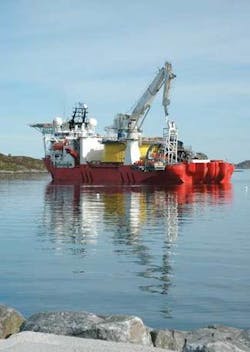Cylindrical drilling platform tailored for deepwater and ultra-harsh environments
Nick Terdre, Contributing Editor
Sevan Marine has further developed its Sevan Stabilized Platform (SSP) concept for application as a drilling rig. The SSP Drilling Unit is suited particularly for ultra deepwater and harsh-environment operations. Construction has begun on the first unit, with delivery scheduled for the first half of 2009.
The cylindrical SSP concept has been applied initially as a floating production platform for both deep waters and marginal fields. The first two such FPSOs are under construction for Petrobras’ Piranema field in 1,000 m of water off Brazil and Venture’s small Chestnut field in the UK sector.
The concept has favorable heave and roll motions because of the circular shape and a motion-damping bilge keel. This makes it a suitable platform for drilling as well as production operations. The drilling concept, like the production concept, also benefits from ease of construction.
Another big attraction is the SSP Drilling Unit’s price. According to VP Fredrik Major, the all-in delivery cost is $430 million, compared with $500-600 million for typical sixth generation semisubmersibles and top-of-the-range drillships.
Another stand-out feature is the unit’s variable deckload capacity of more than 15,000 metric tons. This compares favorably with the latest generation semis, which have 50% less variable deckload capacity, at around 7,500 metric tons. It is on a par with deepwater drillships, which have a variable deckload capacity of 15-20,000 metric tons.
The deepwater capability of the design is related partly to the high deckload capacity, which enables 12,500 ft of risers to be stored, says Bjørn Egil Gustavsen, SSP Drilling Unit project manager. In addition, the design offers high mud volume capacity with large bulk storage for bentonite and barite, a high hoisting capacity, and motion compensation. Efficient station-keeping is maintained by a DP3 system. For shallow water operations, there is an optional mooring system with thruster assist.
The unit has a high storage capacity for fuel and consumables compared with drillships and semis, which minimizes the resupply requirement and facilitates remote operations. If required, up to 200,000-bbl oil storage capacity is available in the hull.
The favorable motions plus large deckload and storage capacities also make the unit suitable for harsh environment drilling. The unit has high stability reserves, which means more heavy equipment can be stacked on at higher levels than on a semisubmersible rig. In North Sea conditions, it can carry on with drilling operations in up to 8 m significant wave heights, equivalent to peak waves of up to 14.8 m.
In anticipation of future Arctic drilling operations, Sevan prepared the design for full winterization and enclosure of all sensitive equipment. With its steel construction being able to cope with temperatures down to -20°C, the rig is equipped for operations in all ice-free areas, including the Barents Sea.
The design also delivers environmentally friendly and safe operations, and complies with rules and regulations for all environmentally sensitive areas, Sevan says. It incorporates a closed drain system with zero discharge, a waste management system, and low emission engines. Safe operations are enhanced by the high stability reserves, and environmental protection by the double side and double bottom. The internal storage capacity, a feature not shared by semisubs, enables the unit to conduct extended well testing, including in environmentally sensitive areas like the Barents Sea.
The two deck cranes are designed for safe lifting operations, and pipe-handling is automated. Drilling operations also are automated to a large degree. There is a single derrick but offline activities are possible, for example, standbuilding of drillpipe or casing while drilling is under way. The derrick also has offline capability - this means the riser can be moved up to 11 m away from the drilling center, making it possible to install a christmas tree without retracting the riser, thus saving a time-consuming trip.
Construction of the hull for the first SSP Drilling Unit began this summer on a speculative basis. This is taking place at the Hantong Shipyard in China, which Sevan has also contracted for the hull construction for the fourth SSP production platform. The company has agreed to lease dedicated parts of the Hantong yard on an exclusive basis until the end of 2012, which will enable up to nine additional SSPs to be built, both drilling units and FPSOs.
Separately Sevan signed a mandate with GE to arrange construction finance and a term loan, both of up to $100 million, to partially finance the first drilling unit, which will be owned by Sevan Drilling Pte. Ltd., to be established in Singapore as a wholly-owned subsidiary of Sevan Marine.
The company also has agreements with main equipment suppliers regarding supply of equipment for the first two drilling units as follows:
- Nymo yard in Norway for fabrication of drilling and mud modules
- Aker Kvaerner MH for the drilling package
- A consortium formed by Siemens and Rolls-Royce for supply of DP package, thrusters, control system, and power generation.
Despite the current rig building boom, Sevan still expects a shortage of units for the more demanding drilling assignments when its first unit is delivered in less than three years’ time.


